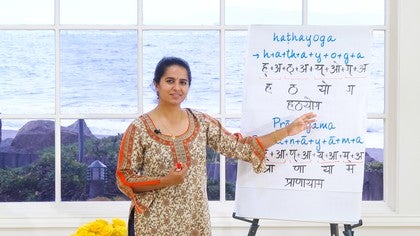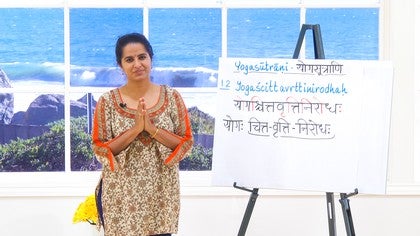Description
About This Video
Transcript
Read Full Transcript
Namaste dear friends and it's very good to have you back again. Thus far we have been seeing the different letters of the Sanskrit alphabet. We saw how to write the vowels, how to write the consonants and then we also did a little bit of playing with how the consonants combine with the vowels. So what we'll do is as a next step, as a next logical step of this journey, let us see how these consonants combine with the vowels and now these different syllables come together as words because that is what we are really interested at getting to, how the words form in the Sanskrit language. So I have up here a few words that in the yoga world you will be very familiar with and sometimes there is a slight confusion about the pronunciation of certain of those words because you see we write them in the Roman script which is what we use to represent the English language.
We don't always use the dots and the lines to indicate the equivalence of the Sanskrit language sounds. So here we go, we have ha-ta-yoga. You see what I mean? You might have often heard it pronounced as ha-ta-yoga because when you just write it in plain English you will not write this dot below it and then of course you are perfectly right when you pronounce it as ha-ta-yoga but this th here is representing the Sanskrit sound tah which is a cerebral sound and therefore when you want to indicate this word with its correct phonetics it becomes useful to add that dot below it. Once you know that then even if you don't see the dot you will still pronounce it right but we will also investigate the sound using the Sanskrit script itself which is the devanagari script.
So here we have the devanagari script with the different letters that are represented. So we have the ha, the phoneme ha which is represented by this letter, the vowel a-ta-yoga. Personally I find that fascinating about the Sanskrit language the way in which you can literally break up a word component by component, sound component by sound component and then recompose it all together. So here we have this ha-ta-yoga which is actually a composite of all the different phonemes ha-ta-yoga. It's like you really do a slow motion of the word and that is what you will come to.
Now how they combine together is you have the phoneme ha-ha with the vowel a and that together gives you the complete ha and that is how you would often see it represented in the Sanskrit alphabet. The phonemes are combined with the vowel a. The second one is ta again with the vowel a and that is how it looks ta. Make sure that your tongue is rolled up and the tip of your tongue is touching the center of the roof of your mouth ta. Then you have the y with the vowel o.
The vowel o is represented by this extra line and the antenna and then we have the g. So ha-ta-yoga and putting it all together ha-ta-yoga. You would notice that here we have these mini lines on top of the head there. That is really to help you see the letters independently and when you put it all together in one word then that line covers the whole word to indicate that that is one section or that is an individual component of a word. So here we have ha-ta-yoga.
Just a small note on that is that the sound ta is important because it means something. Ha-ta means force and ha-ta does not mean anything. So when you say ha-ta-yoga what you are saying is that you need to add force. You need to force your body into certain postures that your body is not habitually used to or that you move your breath in a certain manner that is not your, that is beyond your regular comfort zone and therefore the concept of force, ha-ta. They also say that ha represents the ida nadi, one of the energy centers or energy channels and ta represents the other one, the pingala.
So ha-ta-yoga is also a way of balancing these two energy channels within our body. So you see it does make a difference if you say ha-ta-yoga which would have no correspondence in truth in terms of what it represents and when you say it as ha-ta-yoga. So practice along a little bit. It might seem daunting initially but it is not, it is all about courage. Yoga is really about courage, the courage to let go of your conditionings, be open to the new, be open to the true and then it is bound to come.
Believe me. We will move on to the next one which is another important word in the yoga tradition which is sometimes pronounced as pranayama. If you break it down to its individual syllable components, this is what we get, pranayama and then we break it down even more into the independent phonemes. We get p-r-a-n-a-y-a-n-a. We start putting it together.
The vowels help us to complete the individual syllables. Here we have the p-r-a-n-a with the vowel a and that is indicated by this extra line on the side. You see here there is no extra line. If there was an extra line, it would have been ha but without that extra line, you get the ha. Here if that extra line was not there, we would have got the pr.
The moment you put that extra line, it becomes pr. The same with this, we have the n which is again a cerebral sound where the tip of the tongue rolls in also indicated by that dot below. The moment you see a dot below, the tongue goes up to the roof of your mouth. That is a n-a-n-a. Then we have the semi-vowel e with the vowel a, so ya and then the sound n with the vowel a, so m.
Now when we start combining it together, it becomes pr-a-n-a-y-a-m. Did you get that? Once more pr-a-n-a-y-a-m and if you put it fast, it becomes pr-a-n-a-y-a-m. Once more pr-a-n-a-y-a-m, prana you know meaning the breath and ayama the movement of the breath. So pr-a-n-a-y-a-m is the way the breath moves or the control also.
One note on the writing of the letters, when you have an r which is just half or rather the phoneme r, it often gets represented as that line below the letter. We have the p and half the r goes below it like that, so pr-a-r and that is the pr-a-r. Want to say it once last time, pr-a-n-a-y-a-m. Want to close your eyes and try seeing if you can recognize what it looks like, pr-a-n-a-y-a-m. Uttamam means excellent, well done.
The word hatha yoga once last time, hatha yoga. Enter this image in your mind's eye, close your eyes, see if you can reproduce it, ha-ta-yo-ga. Uttamam again, excellent, thank you. Look at different Sanskrit words, see if you can dissect the sounds and then try writing them. Enjoy, bye-bye.
Mother Tongue: Sounding the Words
Comments
You need to be a subscriber to post a comment.
Please Log In or Create an Account to start your free trial.










